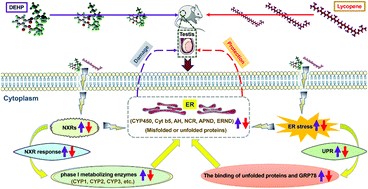Lycopene prevents DEHP-induced testicular endoplasmic reticulum stress via regulating nuclear xenobiotic receptors and unfolded protein response in mice†
Abstract
Lycopene (LYC) is a potent antioxidant synthesized by red vegetables or plants. Di-2-ethylhexyl phthalate (DEHP) is frequently detected in diverse agricultural environments and considered as a reproductive toxicant. The present research was designed to assess the potential mechanisms of DEHP-induced testicular toxicity and the treatment efficacy of LYC. In this study, after the oral administration of LYC at the dose of 5 mg per kg b.w. per day, mice were given 500 or 1000 mg per kg b.w. per day of DEHP. This research suggested that LYC prevented the DEHP-induced disorder at the levels of activity and content of CYP450 enzymes. LYC attenuated DEHP-caused enhancement in nuclear xenobiotic receptors (NXRs) and the phase I metabolizing enzymes (CYP1, CYP2, CYP3, etc.) levels. Furthermore, endoplasmic reticulum (ER) stress was induced by DEHP and triggered unfolded protein response (UPR). Interestingly, LYC could effectively ameliorate these “hit”. The present study suggested that LYC prevents DEHP-induced ER stress in testis via regulating NXRs and UPRER.



 Please wait while we load your content...
Please wait while we load your content...